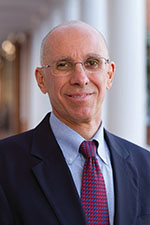7 minutes
How CEO Institute sharpens executives’ skill in handling today’s challenges
Today’s CEOs and executives help their credit unions face a diverse array of daunting challenges. For example, Lou Centini has often talked with executives who are grappling with post-merger integration.
“How to merge two diverse cultures into one new, higher-performing one, ... and how to best integrate systems and processes, such as IT, HR, operations and so on” is a big challenge many CU leaders face, explains Centini, founder/CEO of LJ Centini & Associates LLC, a Charlottesville, Virginia, management consulting and executive coaching firm. “Other examples include how to deal with competitive challenges in the market ..., how to deal with ethical issues in management ranks, and how to create and sustain high-performing teams.”
Jim Austin, president of JH Austin Associates Inc., a Chicago-based affiliation of consultants engaged in executive education and strategic planning, has identified acquiring and retaining talent, local economy impacts and online banking as the three main concerns of CU CEOs.
That Centini and Austin understand so clearly what CU leaders grapple with is unsurprising. In addition to working as consultants, they’re faculty members for CUES’ CEO Institute. Centini is a visiting executive lecturer for the Darden School of Business at the University of Virginia and a lead teacher for CEO Institute III: Strategic Leadership Development. Austin is program integrator and instructor at CEO Institute I: Strategic Planning at Wharton, at the University of Pennsylvania, Philadelphia. (Cornell University hosts CEO Institute II: Organizational Effectiveness in Ithaca, New York. More on that later.)
In their respective segments, Centini and Austin teach CU executives how to confidently and skillfully lead their organizations to desired outcomes.
Launched in 1997, the three-segment CEO Institute was designed to develop executives’ strategic leadership skills, says Christopher Stevenson, CIE, SVP/chief learning officer for CUES. In addition to the Wharton, Cornell and Darden institutes, CUES offers Strategic Growth Institute™ at the University of Chicago’s Booth School of Business; Strategic Innovation Institute™ at Stanford Graduate School of Business; and CUES Governance Leadership Institute™ at the University of Toronto’s Rotman School of Management. (The Rotman program is designed for board members, Stevenson notes.)
Facilitating Leader Learning
When it comes to developing and refining the institute programs offered by CUES, Stevenson identifies content CU leaders could benefit from, as well as the faculty and business schools that could best teach those ideas.
“Leaders learn best when there is direct application to the work they’re doing,” Stevenson says. “A successful program cannot divorce the content from what is actually happening in the office. This requires that CUES and our partner business schools have an in-depth understanding of the challenges and opportunities presenting themselves every day in credit unions.”
CEO Institute features a project between segments I and II and segments II and III. Participants begin their week at Darden talking about their between-segment projects, Centini says, first in a small-group setting and then in the larger classroom.
Stevenson says successful CU leaders need to have a thorough understanding of their own credit unions and local markets, the CU industry and the wider financial services industry. But, he emphasizes, they can gain invaluable perspective from studying other industries. Business case studies are often used at CEO Institute because they offer the chance to “push leaders into unfamiliar territory and out of their comfort zones” into a different way of thinking, he explains.
“These promote a robust classroom discussion, including a fair amount of disagreement about the best possible decision,” Stevenson says. “And then we apply the lessons learned to the participants’ own credit unions. It’s an outstanding way to eliminate blind spots.”
Centini echoes Stevenson’s comments about case studies, noting that the real situations the cases present generate spirited discussion among participants and spur deep thinking. In the Darden segment, Centini also presents leadership concepts, models and frameworks and invites participants to take part in simulations and experiential activities.“The cornerstone of my teaching is high-engagement learning,” Centini says. “This includes creating an environment that is highly interactive and challenges participants to take responsibility for their own learning. I want participants to elevate their critical-thinking skills so they can apply them to a range of situations they may face in the future.”
Facilitating Learning from Peers
Interactive and experiential learning is an approach favored by Beta Mannix as well. She is faculty director for CEO Institute II.
“I try to create an informal space where interaction is high and participants can learn from each other as much—if not more—than from me,” says Mannix, the Ann Whitney Olin Professor of Management at Cornell University’s SC Johnson School of Business. “I know time is precious for CUES participants, so I want what we do to be directly relevant and applicable. They should be able to use what we do in the classroom when they get back to work on Monday.”
As an example, she mentions a current participant who is trying out many of the concepts and exercises she presented with his 80-person staff.
“He says engagement is higher than ever,” Mannix says. “That’s exciting. Other individuals have been able to use the frameworks [presented] to make such changes as going paperless or executing succession plans more smoothly. That is all rewarding to hear.”
Austin says he never lectures. “I always try to create experiential learning environments. I’ll typically introduce a concept or framework, flesh it out for 10 or 15 minutes, and then have an exercise or case that tests the ideas, challenging leaders to apply them in their own terms or situation … with more discussion than PowerPoint [affords].”
Mannix prefers a less-is-more approach when it comes to her classroom teaching technique. Providing adult learners time and space to mull over and absorb the concepts and to share knowledge with each other has proven very effective, she says. Consequently, Mannix introduces fewer ideas, but then explores these in-depth so participants can fully understand the applications and their impacts. She also spends a great deal of time helping leaders know their own purpose and strengths.
“If you can clearly articulate your purpose, from that so many other things flow—what you champion, how you will make decisions, how you define yourself and add value and how you will act with courage when necessary,” Mannix explains. “Purpose, values, strengths—these are critical to know and build on as a leader.”
Centini’s CEO Institute III participants learn a lot about themselves—and deepen their trust of their classmates—when they step outside of the classroom one day midweek for a day of experiential learning at a ropes course, he notes.
A Formula That Works
“I’ve heard some amazing success stories of how [CEO Institute] participants have transformed their credit unions—reorganizing [them] to become more customer-focused, planning and executing mergers, implementing sales cultures, and revamping HR systems,” says Centini. “And I’ve witnessed some leadership breakthroughs at an individual level.”
Stevenson has heard “hundreds of success stories” as well, mentioning one instance in which a credit union lost its sole sponsor. However, because of the executive’s work at the institute, a contingency plan was in place. Another CEO Institute participant was hired as the executive charged with turning around a credit union.
“He led major changes throughout the organization, including reinvigorating the brand and enhancing the technology strategy,” Stevenson recalls. “In just a few short years, he has righted the shop and breathed new life into the struggling organization, which is now enjoying robust growth.
“That’s the purpose of CUES Institutes—developing leaders who can shepherd their organizations to success, even in uncertain or challenging circumstances,” Stevenson continues. “The market will continue to shift and change, and credit unions will face more threats from unexpected places. But when a leader has a deep knowledge of strategy and how to manage uncertainty, they are equipped to ride out the storm.” cues icon
Pamela Mills-Senn is a freelance writer based in Long Beach, California.
Instructors Matter, Too
The faculty members of CEO Institute wouldn’t promote themselves, but this is true: They’re awesome and a big part of what makes the leadership learning at each segment so successful. Here’s a little more background on each of them.
In addition to serving as president of JH Austin Associates Inc. and as program integrator and instructor for CEO Institute I for eight years and counting, Austin is an adjunct senior lecturer at Brown University in Providence, Rhode Island. There he teaches the semester-long leadership and marketing course in the executive master’s in healthcare leadership program. Over the past decade, Austin has worked with multiple credit unions on board governance, strategy development, innovation and scenario planning, and has twice led ExecuBlend™ (cues.org/eb) sessions in Santa Rosa, California.
 Mannix has taught at Cornell University and been the faculty director for CEO Institute II for 20 years. In this role, she designs the program and coordinates with the other CEO Institute faculty directors. Before this, she was a faculty member at Columbia Business School, New York, and the University of Chicago. She is in the second year of a three-year term as an associate editor at the highly regarded Academy of Management Review. This is the second time she has served as an associate editor of the publication. She teaches and works in the areas of leadership, organizational change, creativity and innovation, and diversity.
Mannix has taught at Cornell University and been the faculty director for CEO Institute II for 20 years. In this role, she designs the program and coordinates with the other CEO Institute faculty directors. Before this, she was a faculty member at Columbia Business School, New York, and the University of Chicago. She is in the second year of a three-year term as an associate editor at the highly regarded Academy of Management Review. This is the second time she has served as an associate editor of the publication. She teaches and works in the areas of leadership, organizational change, creativity and innovation, and diversity.
 CEO of LJ Centini & Associates, LLC, Centini was on the original design team that created CEO Institute. He has been on the faculty of CEO Institute III for the past three years. Before this, and since the inception of CEO Institute III more than 20 years ago, he was executive director and faculty leader for the program at Darden. Over the past 25 years Centini has taught a variety of executive education programs, presented sessions at several CUES conferences, and created and taught two online courses on transformational leadership for CUES. In addition to coaching numerous credit union executives, Centini also teaches in three executive MBA programs targeted at aspiring education leaders.
CEO of LJ Centini & Associates, LLC, Centini was on the original design team that created CEO Institute. He has been on the faculty of CEO Institute III for the past three years. Before this, and since the inception of CEO Institute III more than 20 years ago, he was executive director and faculty leader for the program at Darden. Over the past 25 years Centini has taught a variety of executive education programs, presented sessions at several CUES conferences, and created and taught two online courses on transformational leadership for CUES. In addition to coaching numerous credit union executives, Centini also teaches in three executive MBA programs targeted at aspiring education leaders.





